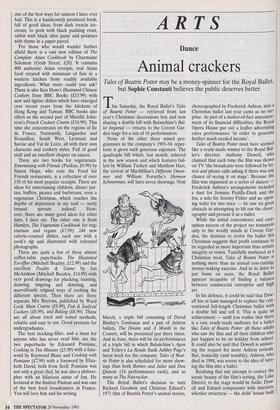ARTS
Dance
Animal crackers
This Saturday, the Royal Ballet's Tales of Beatrix Potter — retrieved from last year's Christmas decorations box and now sharing a double bill with Balanchine's Bal- let Imperial — returns to the Covent Gar- den stage for a run of 16 performances.
None of the other three mixed pro- grammes in the company's 1993-94 reper- toire is given such generous exposure. The quadruple bill which, last month, ushered in the new season and which features bal- lets by William Tuckett and Matthew Hart, the revival of MacMillan's Dtffereii t Drum- mer and William Forsythe's Herman Schmerman, will have seven showings. Next March, a triple bill consisting of David Bintley's Tombeaux and a pair of Ashton ballets, The Dream and A Month in the Country, will be presented just three times. And in June, there will be six performances of a triple bill in which Balanchine's Agon and Tetley's La Ronde flank Ashley Page's latest work for the company. Tales of Beat- rix Potter is also scheduled for more show- ings than both Romeo and Juliet and Don Quixote (14 performances each), and as many as The Nutcracker.
The Royal Ballet's decision to turn Richard Goodwin and Christine Edzard's 1971 film of Beatrix Potter's animal stories, choreographed by Frederick Ashton, into a Christmas ballet last year came as no sur- prise. As part of a matter-of-fact announce- ment of its financial difficulties, the Royal Opera House put out a leaflet advertising extra performances 'in order to generate further much needed income'.
Tales of Beatrix Potter must have seemed like a ready-made winner to the Royal Bal- let's director, Anthony Dowell, who claimed that each time the film was shown on TV 'the broadcasts were followed by let- ters and phone calls asking if there was any chance of seeing it on stage'. Because the film was organised as a series of dances Frederick Ashton's arrangements included a duet for Jemima Puddle-Duck and the fox, a solo for Jeremy Fisher and an open- ing waltz for two mice — he saw no great obstacle in attempting to lift out the chore- ography and present it as a ballet.
While the initial convenience and easy- option success of the project are testament only to the woolly minds at Covent Gar- den, the decision to revive the ballet this Christmas suggests that profit continues to be regarded as more important than artistic integrity or vision. Tastefully marketed as a Christmas treat, Tales of Beatrix Potter 15 nothing more than an annual cost-cutting, money-making exercise. And in its drive to put bums on seats, the Royal Ballet appears incapable of finding a balance between commercial enterprise and high art.
In his defence, it could be said that Dow- ell has at least managed to replace the con- ventional full-length Christmas ballet with a double bill and sell it. This is quite an achievement — until you realise that there is a vast, ready-made audience for a ballet like Tales of Beatrix Potter: all those adults who saw the film and all their children who just happen to be on holiday from school. It could also be said that Dowell is answer- ing the request for more Ashton revivals. But, ironically (and sensibly), Ashton, who died in 1988, was averse to the idea of turn- ing the film into a ballet. Realising that any attempt to convey the scenic beauty of the film's setting, the Lake District, to the stage would be futile, Dow- ell and Edzard compensate with interiors, whether structural — the dolls' house built
to scale for the Tale of Two Bad Mice or in the form of painted backcloths and screens — like those used to create the illu- sion of a huge staircase looming behind Johnny Town-Mouse and Mrs Tittlemouse. The biggest disappointment is Edzard's lily pond for Jeremy Fisher. In the film, Potter's frog, conceived and thus dressed as a gentleman angler, leaps through an open window from his pondside garden. The camera takes us into his house where, ankle-deep in water, he is seen slipping and darting between rooms. In the ballet, the frog is limited to his fishing expedition on the lily pond, and the moment when he splashes face down into the water is poorly substituted by his tumbling out of sight, the sound of impact followed by a pathetic spray of aqua glitter. Minor detail is also lost in transferring the film's action to the stage. Jemima
Puddle-Duck's encounter with the fox is
made far more sinister by way of the screen close-ups of the fox's sandy-haired hand
holding open his Fur and Feather newspa- Per at the cookery page, which gives instructions for 'Duck with Sage and Onion Stuffing'. But in the ballet we can barely see the word 'recipe' on the leaflet he clutches.
Potter's stories are often perceived as the sweet, innocent adventures of flopsy bun- nies and naughty squirrels, but the author- Illustrator had a darker side and her real-life animal models used for the book's characters often met untimely, unpleasant ends. Mrs Tiggy-Winkle, the hedgehog, was Put down with chloroform. Hunca Munca, a mouse, fell to her death after a bout of acrobatics on a chandelier. Nor was Potter sentimental about animals. In her later Years, when she devoted herself to farming, she would often send Christmas gifts of home-produced pork to her publishers. However misguided Dowell's project, it Would be unfair to say that he has approached it carelessly. Yet Ashton's choreography has not been lovingly pro- tected and the dancers — a generation to Whom Ashton's quintessential English style does not come naturally — can only battle their way into his manner. Encased in Ros- tislav Doboujinsky's masks and hindered by kapok-stuffed costumes, they appear mere- ly as expensive, frivolous novelties. And this return-to-the-nursery ballet version reflects the mediocrity of the original film, Which is neither old enough to be of histor- ical interest nor an example of Ashton's best work.
That the Royal Ballet and its public need a challenge, not a comforter, is brought home with increasing urgency when you see men in suits reduced to a state of gaga idiocy (only half of it due to alcohol con- sumption), clapping in time to the music, and when you hear the gooey `aaahs' of women who still collect cuddly toys. It would come as no surprise if the crush bar started serving Heinz baby food-filled sand- wiches during the interval this Christmas.











































































 Previous page
Previous page